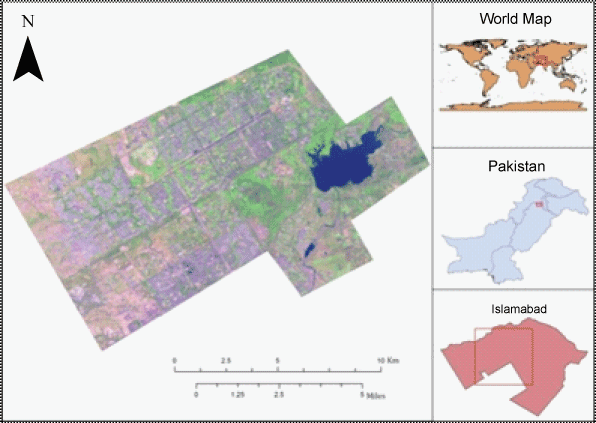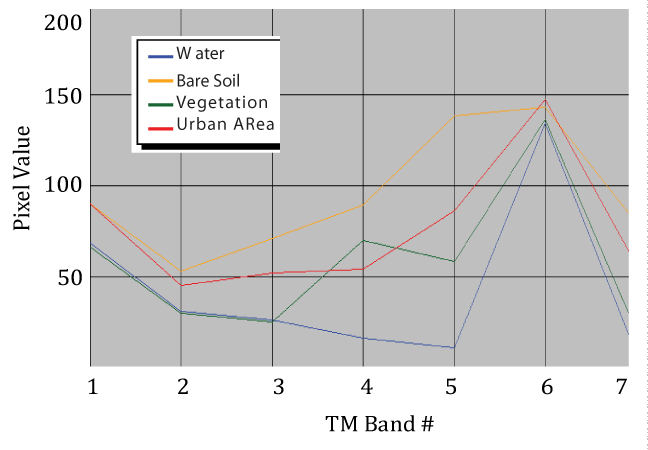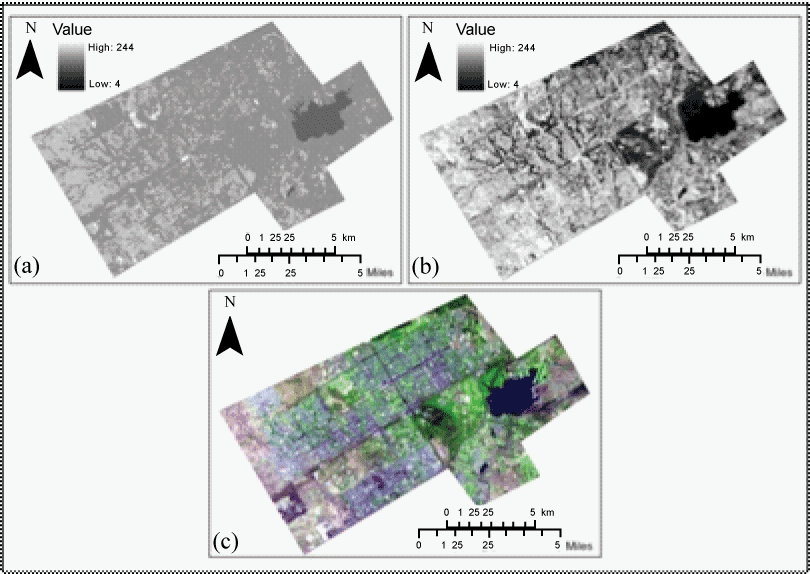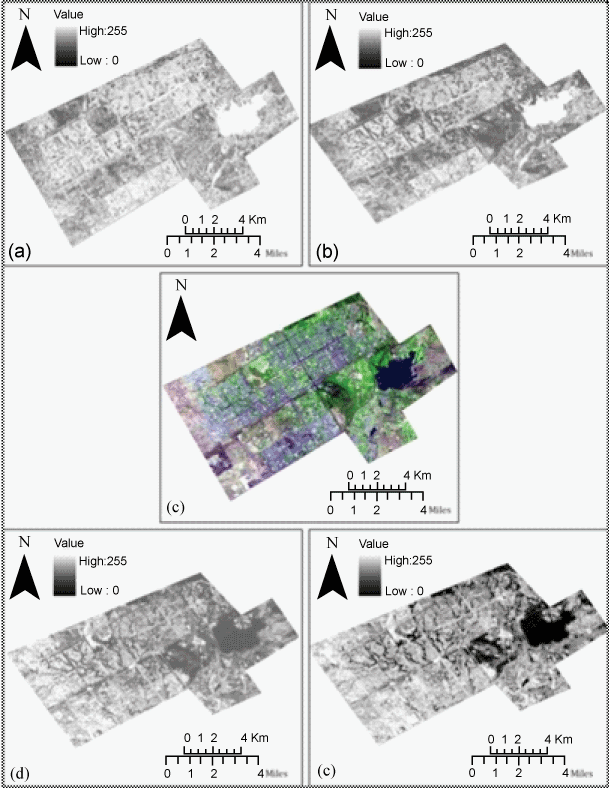| Research Article |
Open Access |
|
| Mirza Muhammad Waqar1*, Johum Fatimah Mirza1, Rafia Mumtaz2 and Ejaz Hussain1 |
| 1Institute of Geographical Information Systems, School of Civil and Environmental Engineering, National University of Sciences & Technology, Islamabad, Pakistan |
| 2Department of Computing, School of Electrical Engineering & Computer Science, National University of Sciences & Technology, Islamabad, Pakistan |
| *Corresponding authors: |
Mirza Muhammad Waqar
Institute of Geographical Information Systems
School of Civil and Environmental Engineering
National University of Sciences & Technology
Islamabad, Pakistan
E-mail: mirza.waqar@seecs.edu.pk |
|
| |
| Received March 08, 2012; Published June 25, 2012 |
| |
| Citation: Waqar MM, Mirza JF, Mumtaz R, Hussain E (2012) Development of New Indices for Extraction of Built-Up Area & Bare Soil from Landsat Data. 1: 136. doi:10.4172/scientificreports.136 |
| |
| Copyright: © 2012 Waqar MM, et al. This is an open-access article distributed under the terms of the Creative Commons Attribution License, which permits unrestricted use, distribution, and reproduction in any medium, provided the original author and source are credited. |
| |
| Abstract |
| |
| This paper presents development of new indices for the identification of built-up area and bare soil from medium resolution remote sensing data, extraction of these two spectrally confusing classes has always been a problem. For nearly three decades extensive research efforts have undergone for the development of various techniques including a number of indices to extract land cover features especially if suitable thresholds are used. These indices include for example NDVI (Normalized Difference Vegetation Index), NBI (Normalized Built up area Index), NDISI (Normalized Difference Impervious Surface Index) & NDWI (Normalized Difference Water Index). All these indices use various combinations of bands in order to extract a particular land cover, and their performance depends upon spectral response of the features. As spectral response of land cover features varies from region to region due to climatic & topographic changes so are their spectral curves. Due to this reason, indices developed for one area can’t be effectively applicable to another area. In this research, a few new indices have been proposed for the extraction of bare soil and built-up area using medium resolution satellite imagery (LandSat 30m). A comparison has been made among newly developed indices and previously used indices. The results show that newly developed indices for built-up area and soil increases accuracy up to 10-13% as compared to previously developed indices. |
| |
| Keywords |
| |
| Indices; Built-up; Urban; Soil; Extraction |
| |
| Introduction |
| |
| The availability of remote sensing data greatly helped mapping and managing earth resources, but its contribution in assessment of temporal changes has been widely used and proved beneficial. However, because of various factors such analysis did not yield acceptable results. One of such situations is the confusion among various land cover classes. To overcome such confusions and to improve land cover classification results, different techniques have been used and ration/ indices are among those. These indices do help separating various complex land covers, but still separating some land covers poses problems. This research paper deals with the development of a few new Indices for better separation and extraction of bare soil and built-up area. In general, the usage of high-spatial resolution remote sensing data such as QuickBird, IKONOS, and large-scale aerial photos can give better results for urban land-cover and land use classification because of the spatial complexity of components in the urban area such as buildings, roads, runways, vegetation, concrete, asphalt, and soil. An urban component covering a small area cannot be detected in the low- to medium spatial resolution data because it can mix with other components within a pixel. |
| |
| Since high spatial resolution data have been costly, many researchers have concentrated on improving the accuracy of urban land-cover classification using medium-spatial resolution remote sensing data, e.g. Landsat Thematic Mapper (TM) and Enhance Thematic Mapper plus (ETM+). However, the coarse resolution hinders separating each component in an urban environment [1]. |
| |
| Traditional classification approaches are mostly pixel-based; each image pixel represents one land-cover. Due to t urban complexity, spectral reflectance may represent the combination of several land covers called as mixed pixel [2]. More over supervised classification is laborious and has a high probability of misclassification between bare soil and urban land, since both land covers can have similar spectral signatures at some places. On the other hand, various previous studies [3,4] indicates that the indices can be used to extract land features efficiently especially if a suitable threshold is used. The normalized built-up index (NDBI equation (i)) and New Built-up Index (NBI equation (ii)) was used to map urban areas automatically [5,6] proposed a bare soil index (NDSI equation (iii)) to derive bare land. However, their performance varies from place to place and bands that participate in extracting different land cover may change due to geography of a particular area. This phenomenon is particularly evident in case of soil and urban area i.e. one index developed to differentiate a particular urban area/city and bare soil may not necessarily apply to another area because spectral variance in response to soil and built up surfaces. |
| |
| NDBI = (TM5 – TM 4) / (TM5 + TM4) ------------ (i) |
| |
| NBI = (TM3*TM5)/TM4 --------------------------- (ii) |
| |
| NDSI = (TM5 - TM 4) / (TM5 + TM4) ------------ (iii) |
| |
| Study area and data |
| |
| Study area: The study area is Islamabad, the capital of Pakistan. Geographically it is located in Pothohar Plateau; 33°43’N 73°04’E in the north of the country. Its total area is 46.3 sq miles is divided into five major zones: Zone I, Zone II, Zone III, Zone IV, and Zone V (land use zones). Our study area consists of complete Zone I and partially Zone III which consists of main built-up area and reserved green area of the city (Figure 1). |
| |
|
|
Figure 1: Landsat TM image of Study area(TM bands RGB: 542). |
|
| |
| Satellite data & pre-processing: Landsat TM image of June 5, 2011, geometrically corrected level 1A has been used in this study being cloud free and of good quality. Thermal band was resampled at 30m in order to match spatial resolution of other reflectance bands using Nearest Neighbor resampling method. Then radiometric correction was performed using atmospheric correction model suggested by [7]. After applying radiometric correction, subset image was extracted for the study area as shown in Figure 1. |
| |
| Methodology |
| |
| Analysis of spectral features of study area |
| |
| Spectral signatures of different features including (urban area & bare soil) were analyzed as shown in (Figure 2) to identify unique pattern in each land cover to develop new indices. Spectral signatures analysis of various land covers show better separation of these classes in band 5 compared to others. |
| |
|
|
Figure 2: Spectral profiles of different land covers. |
|
| |
| Creating indices |
| |
| Since the development of NDVI, various other indices have been developed in order to extract land cover from remotely sensed data. The concept for developing such indices is to identify the weakest and strongest reflectance band from multi-spectral data. Then, based on the identified weakest and strongest bands, indices are formed respectively to enhance a particular land cover class [2]. The output of these indices, developed through conventional approach enhanced required land cover over wide range of DN values and suppresses rest of the others. But the major problem with the existing indices developed for soil and built-up area is that they tend to mix with each other. In order to solve such problems, an effort has been made to develop new indices using a different approach. In this approach, unique patterns have been identified in bare soil and built-up area spectral signatures, and bands combinations in which these two land covers have almost similar reflectance with minute differences, are used to develop two new indices. These indices include one for built-up area and other index for bare soil extraction from satellite image. To develop Normalized Builtup Area Index (NBAI) and Band Ratio for Built-up Area (BRBA).TM band 7, 5 & 2 and TM band 3 and 5 were used respectively. In the same way, Normalized Index for Soil was developed using normalized ratio of TM band 6 and 7. These indices are expressed as: |
| |
| NBAI = (TM7 – TM5/TM2)/ (TM7 + TM5/TM2) ------ (iv) |
| |
| BRBA = TM3 / TM5 ------ (v) |
| |
| Soil Index = (TM6 + TM7)/ (TM6 – TM7) ------- (vi) |
| |
| These indices were subsequently used on Landsat TM image to extract built up area and bare soil to test their applicability. These indices extracts the particular land covers over a small range of DN values, but after applying contrast stretch this small range can be stretched to available dynamical range. Such contrast stretch enhances one land cover clearly and suppresses the other. In this way spectrally confusing/ mixed classes were effectively and clearly distinguished from each other. |
| |
| Accuracy assessment |
| |
| To evaluate/compare the accuracy of previously developed and our newly developed indices, these both types of indices were applied on study area seven band Landsat TM satellite image. The resultant images were then compared with high spatial resolution (0.5m) GeoEye as reference image. The reference GeoEye and TM satellite imagery used to evaluate the indices were of same time span and year. The resultant land cover images were overlaid on high resolution reference GeoEye image and then visually compared pixel by pixel. In order to evaluate the accuracy quantitatively, stratified random sampling method was applied. For this purpose 390 points for built-up area and 255 points were taken for bare soil respectively. All the index based extracted images were assessed using the same sample points and results are given in Table 1. |
| |
|
|
Table 1: Summary of accuracy assessment results. |
|
| |
| Results & Discussion |
| |
| Accuracy assessment results show that overall extraction accuracy for built-up area and bare soil using newly developed indices is greater than that of previously developed indices (NBI, NDBI & NDSI). The accuracy of new indices range from 85.5-86.8% for built-up area which is 10-13% higher than that from previously developed indices. In case of soil, the accuracy is 69.4% which is approximately 11% higher than that of NDSI. This shows that indices develop using the proposed method can be used to achieve much better results for extraction and better separation of built up area and soils. |
| |
| For our study area, when previously developed indices for builtup area (NBI, NDBI) were applied, varied results were found with less accuracy (76%, 73%) e.g. NBI enhanced bare soil more than that of built-up area, suppressing water and vegetation. Same results were observed for NDBI but its results were better than NBI, and there is less confusion between built-up area and bare soil (Figure 3d,3e) Similarly, when newly developed indices for built-up area NBAI and BRBA were applied, it extracted built-up more accurately (Figure 3a,3b) but in some portion confusion between built-up area and bare soil still exist. However, the results show that water is also enhanced along with builtup area. As water has greater reflectance value in TM band 2 & 3 and have negligible reflectance in NIR and MIR. When band 2 and 3 used with NIR and MIR in normalized difference ratio they will always result in larger values thus enhancing water along with built-up area, as indicated by Xu Hanqlu in his research “This is always a major problem in previous work and seems impossible to be solved by using original multispectral bands”[9]. This problem can be solved by masking out water first before applying the index. |
| |
|
|
Figure 3: Built-up area extraction results using indices (a) NBAI (b) BRBA (c) Raw Image RGB: 542 (d) NBI (e) NDBI. |
|
| |
| NDSI for bare soil extraction results in enhancement of bare soil but mixes vegetation and built-up area (Figure 4b). While newly developed Soil Index enhanced bare soil and suppressed all other land cover completely except some overlapping with built-up area (Figure 4a). Overall the three developed indices can extract built-up area and bare soil with high overall accuracy. These indices were also applied on three other cities (Lahore, Gujranwala & Karachi) as well, and almost similar results with minor differences were observed. These differences are due to varying topography and climatic conditions that causes change in overall reflectance values [8]. |
| |
| |
|
|
Figure 4: Bare Soil extraction results using indices (a) Soil Index (b) NDSI (c) Raw Image RGB: 542. |
|
| |
| Conclusion |
| |
| The proposed indices can be used to achieve better accuracy; 10- 13% for built-up area and 11% in case of index developed for soil extraction. Although the newly developed indices extracts land cover over small range of DN values and contrast stretching is required to clearly differentiate land cover features, but it better discriminate features and considerably reduces confusion among spectrally similar classes. Secondly, they are simple in application, required less time and pre-processing. Furthermore, these indices can be used to develop images that can serves as a reference for other classification techniques in order to check their accuracy. |
| |
| Acknowledgement |
| |
| This research has been conducted in SEECS & IGIS, National University of Sciences and Technology (NUST), Islamabad, Pakistan. We are thankful to Ibad ur Rehman Raza, (IGIS, NUST), Saqib Ali Kazmi (IGIS, NUST) & Syed Saad Ali for their help in this research. We also acknowledge the facilities that were provide to us in SEECS research lab. In the end, we thank to friends Haseeb ur Rehman (IGIS, NUST) and Faryal Safdar (IGIS, NUST) and our families to make this research task a pleasant journey. |
| |
| |
| References |
| |
- Lu D, Weng Q (2004) âÃâ¬ÃÅSpectral mixture analysis of the urban landscape in Indianapolis City with Landsat ETM+ ImageryâÃâ¬ÃÂ. Photogramm Eng Rem S 70: 1053-1062
- Wu C (2004) âÃâ¬ÃÅNormalized spectral mixture analysis for monitoring urban composition using ETM+ imageryâÃâ¬ÃÂ. Remote Sens Environ 93: 480-492.
- ZAHO. H, CHEN. X (2005) Use of Normalized Difference Bareness Index in Quickly Mapping Bare Areas from TM/ETM+. Geoscience and Remote Sensing Symposium, 2005. IGARSS '05.Proceedings. IEEE International 3: 1666-1668.
- Smith A (2000) Sub-pixel estimates of impervious surface cover using Landsat TM imagery. M.S. Scholarly Paper, Department of Geography, University of Maryland, College Park.
- Rogers AS, Kearney (2004) MS Reducing signature variability in Un-mixing coastal marsh Thematic Mapper scenes using spectral indices. International Journal of Remote Sensing 25: 2317-2335.
- Jieli C, Manchun L, Yongxue L, Chenglei S, Wei H (2010) Extract Residential Areas Automatically by New Built-up Index.18th 2010 International Conference on Geoinformatics. IEEE: 1-5.
- Chavez PS (1996) Image-based atmospheric corrections-Revisited and revised. Photogrammetric Engineering & Remote Sensing, 62: 1025-1036.
- QI Z (1996) Extraction of spectral reflectance images from multi-spectral images by the HIS transformation model. International Journal of Remote Sensing 17: 3467-3475.
- Xu H (2010) Analysis of Impervious Surface and its Impact on Urban Heat Environment using the Normalized Difference Impervious Surface Index (NDISI). Photogrammetric Engineering & Remote Sensing 76: 557-565.
|
| |
| |




